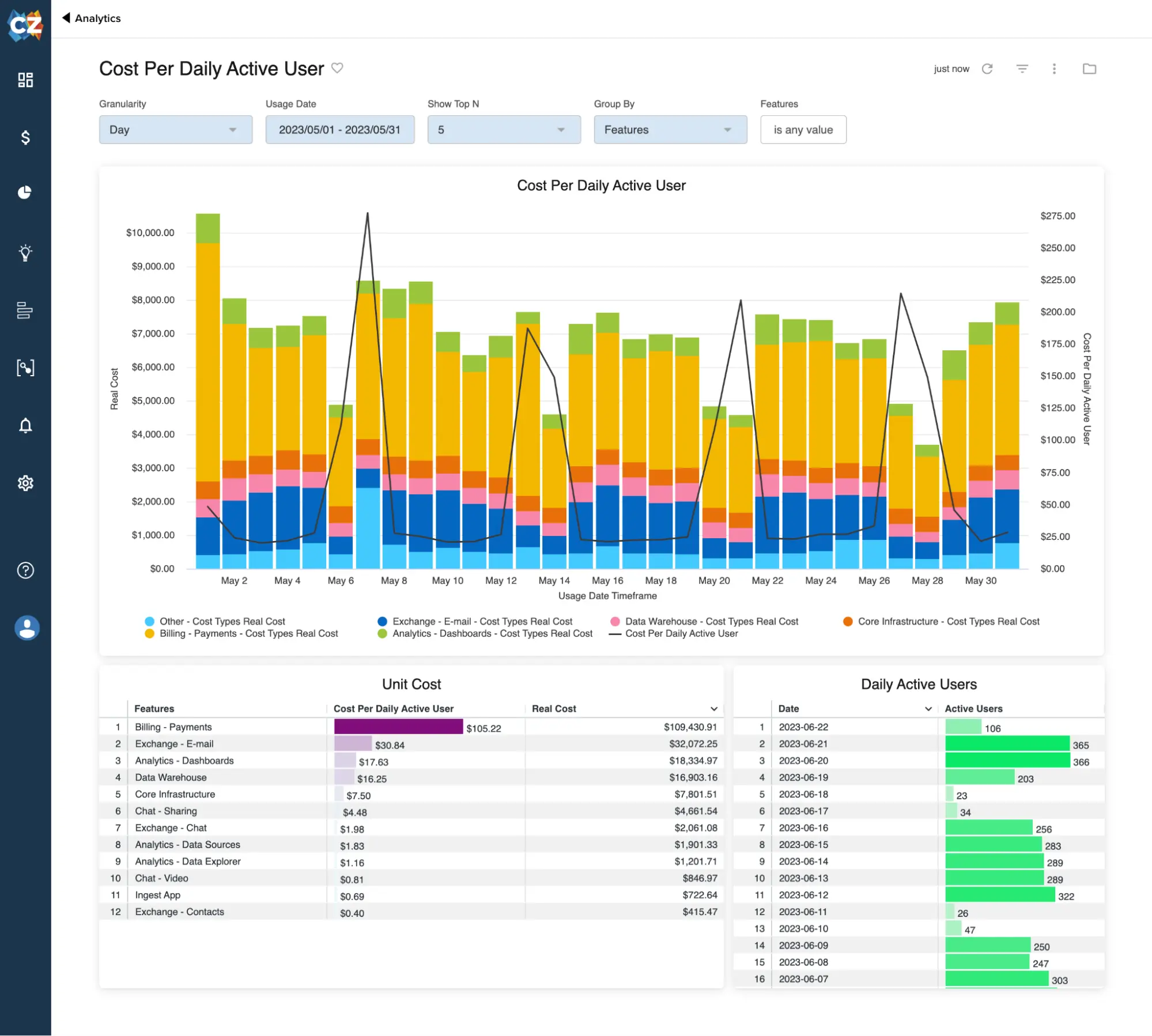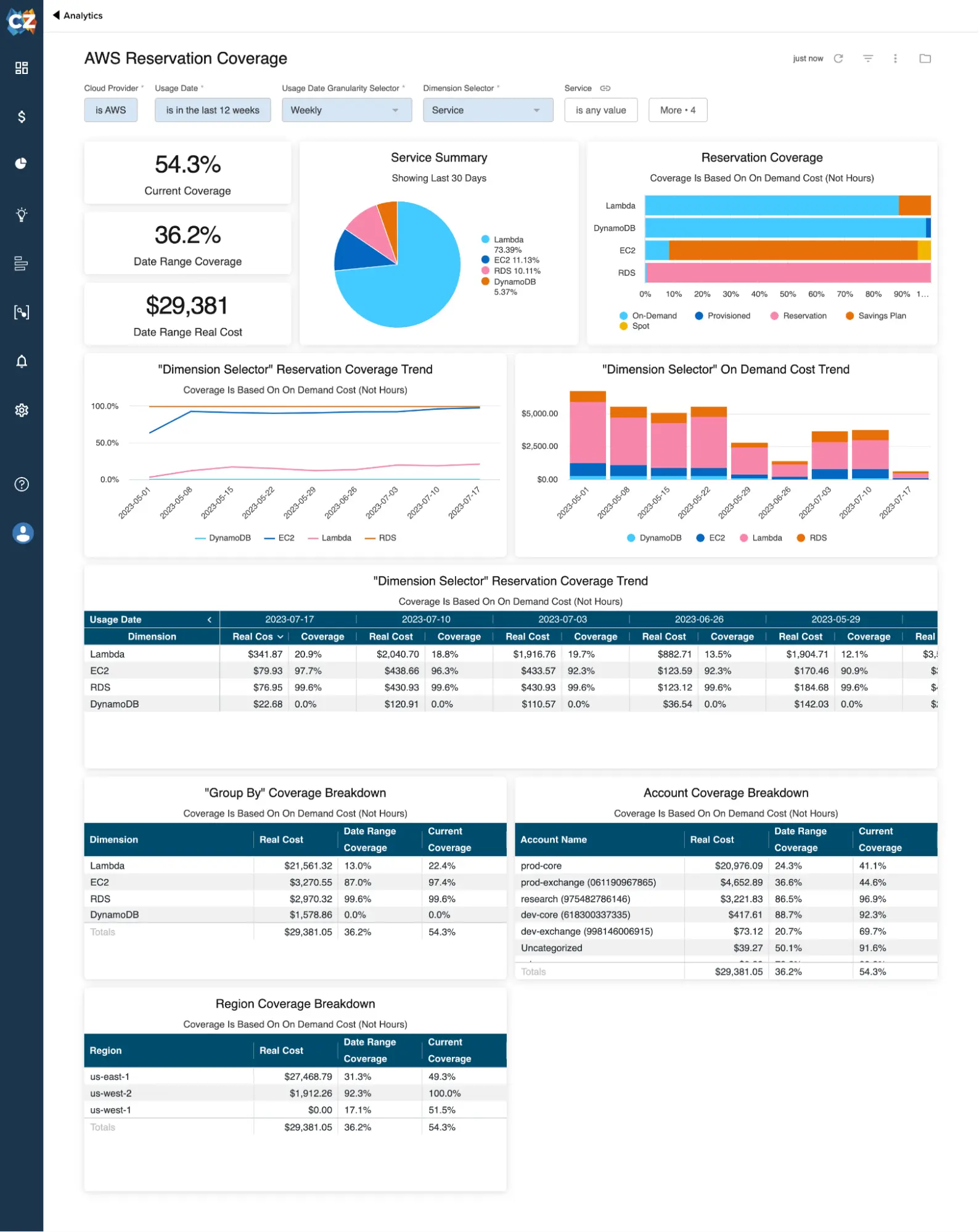We built CloudZero for a simple reason: Bring business fundamentals to cloud-driven organizations without stifling innovation.
It sounds simple, but for years, the intrinsic complexities of the cloud and extrinsic pressures to grab SaaS market share made it near-impossible for businesses to achieve this.
Until CloudZero.
First, we brought cloud-native companies these required capabilities:
- Ingestion. As companies began using more than one cloud service, we built AnyCost™, which ingests 100% of cloud spend (IaaS, PaaS, SaaS) in real time, normalizes it in a common data model, and presents it in a single pane of glass. This gives every cloud stakeholder the most complete, accurate, and granular source of truth of their cloud investment.
- Organization. Businesses struggled to organize their entire cloud spend environments (tagging alone didn’t cut it), so we built CostFormation®, which organizes even the most complex environments in hours — including shared resources, multi-tenant architecture, and Kubernetes.
- Unit Economics. In the same way Ford knows exactly how much it costs in the factory to produce an F-150, CloudZero combines billing data with telemetry data to tell customers exactly how much it costs in the cloud to deliver core value — how much it costs video game companies to develop and host each game, how much each tenant in a multi-tenant app costs, etc.
- Engineering-Led Optimization. In the cloud, every engineering decision is a buying decision; so, every engineer who buys cloud resources should be an informed shopper. So, we show each engineer the costs associated with the infrastructure they own, including real-time data and AI-powered anomaly alerts.
In a normal business context, operating without knowing what you’re spending money on, who’s spending that money, or how much it costs to deliver your core value offering would be considered ludicrous.
For years, it wasn’t considered ludicrous in the cloud — but it should be, and CloudZero is the most powerful platform for bringing business fundamentals to cloud-native business.
Unit economic visibility drives tangible business results: average cloud savings of 22% in the first year of CloudZero deployment, more cost-aware engineering teams, more refined pricing models, and much more.
But as companies mature and scale, the only way to continue realizing savings is through a culture change. All cloud stakeholders must stay committed to FinOps objectives, which requires a single source of FinOps truth.
That includes the underlying data, but it also includes the ability to report on that data in a way that works for your organization, to empower teams with dashboards specific to their missions, and to automate the most impactful cost intelligence processes.
We heard them. That’s why we’re proud to announce the next step in cloud cost intelligence evolution: CloudZero Analytics.
What Is CloudZero Analytics?
CloudZero Analytics empowers our customers to combine business fundamentals with business intelligence (BI), powering advanced operations in the cloud.
It lets customers create custom reports and visualizations based on our powerful data model — in which every penny of your cloud, PaaS, and SaaS spend is converted into a common format — to serve strategic objectives, from the simplest migrations to the most complex unit cost metric analyses.
Analytics automates what would otherwise have required manual digging through our platform. We find that once customers have used CloudZero to correlate cloud usage with business value, they figure out which views most closely represent this relationship; Analytics automates these views, further reducing the manual workload for each engineer.
Also important about Analytics is that it’s primarily self-serve — that is, customers can use it however they want, whenever they want. This puts CloudZero data at your full disposal for understanding your cloud investment:
- Create basic filters using text and date fields
- Construct custom filters using AND and OR logic
- Utilize calculated fields for simple math or data manipulation with formulas
- Incorporate branching logic
- Choose from over 15 data visualizations
These powerful features enable you to surface deep insights, optimize cloud efficiency, and boost profitability by eliminating waste.
Here are a few examples of how CloudZero customers have already used Analytics:
Cost Per Daily Active User (DAU)

Cost per DAU gives companies a comprehensive view of how and when their customers access their products — and how much it costs the customer when they do.
Predictably, this customer saw user activity decrease on the weekends. But the question became: Did their costs decrease appropriately on Saturdays and Sundays? How elastic was their cloud infrastructure — could they scale it down as cost-effectively as they could scale it up?
This data lets engineering teams assess the cost impact of nuanced refactoring — that, without the data manipulability provided by CloudZero Analytics, would never even seem possible.
Status Of Migrations (Kubernetes And Graviton)

It often happens that engineers recognize the potential for greater power — elasticity, accuracy, and/or cost efficiency — in an alternate cloud service. But migrating to the new services involves the potential for process disruption and negative cost consequences, which engineering teams understandably want to anticipate and mitigate.
So, certain CloudZero customers have used Analytics to track the ongoing cost impact of migrations.
This lets them assess both the progress of the migrations — the percentage of resources that have successfully made the transition — and the cost of the migrations, to understand whether costs are expected, and to prompt targeted remediations if not.
Cloud Cost Savings

Two universal goals for CloudZero customers are to: 1. Eliminate wasteful spending; and 2. Ensure efficient bill growth over time. As your business scales, your cloud bill will grow, just as any core investment would — but you need a way to assess whether that growth is healthy.
To serve the twin goals of reducing waste and powering efficient growth, some CloudZero customers have used a dashboard to track their cloud spend before and after CloudZero deployment. In the image above, the thin red line marks the date this customer started using CloudZero.
The blue line represents their actual cloud spend in the date range, and the green line reflects what their cloud spend would have been had it continued growing at the pre-CloudZero-deployment rate.
Clear Out Old EBS Snapshots

Old EBS Snapshots cost you money to store, frequently for no value in return. The Aged EBS Snapshots dashboard highlights snapshots older than 90 days, traces them to their sources, and makes remediation easy.
The Basics
Along with advanced visualizations, Analytics gives customers access to a set of out-of-the-box Standard Dashboards that automatically give your organization state-of-the-art FinOps visibility.
AWS Reservation Coverage

How well are your AWS reservations performing, and where might there be room for improvement?
AWS EC2 Overview

How good is your Effective Savings Rate (ESR), and could a different portfolio of commitments improve it?
Forecasted Month-End Costs

What will you likely spend on the cloud in the next three months? Does it align with your expectations? If not, how might you proactively control it?
Invoice Reconciliation

A seamless alignment of your cloud invoice data and the data in CloudZero’s platform, ensuring data accuracy and simplifying end-of-month reporting.
Tagged Spend Overview

What costs are associated with each of your tag keys? Where might there be opportunities for optimization?
Untagged Spend Overview

Where do you have tagging gaps/inaccuracies, and what’s the quickest way to fill them?
Resource Inventory

A total collation of all your cloud resources, including associated costs, and pointing you to the business units they support.
AWS Reservation Catalog

To help you stay on top of your AWS reservations, the AWS Reservation Catalog dashboard provides a comprehensive roll-off schedule, including reservation start and end dates, and which are set to expire this month.
Cost Reporting By Usage Date

The Cost Reporting By Usage Date dashboard offers a month-over-month-style view of your data, letting you quickly see your monthly cloud resource costs — as raw data, ranked by expenditure, or sorted by any Dimension you want.
Cost Reporting For Finance

Like the Cost Reporting By Usage Date dashboard, the Cost Reporting For Finance dashboard offers a month-over-month view of your data. But it builds on top of the “billing period” date hierarchy to more closely align with cloud provider billing cycles, and allow more seamless integration of billing data into financial reports.
… Anything, Anywhere Else
The best part of CloudZero Analytics is that customers can use it however they want.
They can track any strategic objective, of any level of complexity; view it in whatever format is most convenient for them; and distribute views to whomever needs to see it, as frequently as they need to see it.
Delivery, Exports, And Integrations

Once you’ve generated a view that relates to a strategic objective — finite or evergreen — a number of options are available for sharing and collaboration.
Schedule delivery
Analytics allows customers to generate and send reports based on dashboard views. You can trigger one-time reports whenever you want, or set up recurring reports for ongoing monitoring and accountability — sending your CFO monthly views of unit cost activity, for example, or showing individual engineering teams their weekly S3 usage trends.
Export formats
Users can select either CSV, PDF, or PNG options when exporting a dashboard. If the CSV format is chosen, the dashboard will come in the form of raw data; if PDF or PNG, the dashboard visual itself will be exported. Each export can be sent via email or webhook, with more options forthcoming.
Webhook export
CloudZero’s webhook export lets you integrate Analytics with any automation tool, such as MuleSoft and Zapier, to deliver CloudZero data to hundreds of other applications.
Power Automated Cloud Business Intelligence
All businesses want to bring the world new value — to provide differentiated products and services without getting drowned by the costs to do so.
This requires both business fundamentals and business intelligence, and Analytics makes CloudZero the first platform to power comprehensive business sustainability in the cloud.









